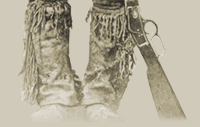 |

Student Process Guide
Choose one of the historical photographs from the Mavericks:
A History of Alberta website. Read any information about the
photograph and examine it. Answer some or all of the following questions
as they apply to each photograph. Complete your work in a journal
format, and add any other information or questions that may not
be included in this guide.
It is said, "A picture is worth a thousand words." Photographs
can provide a great deal of information that is not possible with
words. Remember, though, that the photographer decided what to include
or not include in the photograph, and viewing the photo with a critical
eye is important to anyone examining historical photos. Hunt for
details that offer extra information about the subjects in the photo,
and make sure you ask questions about the photo you are investigating.
1. Description of the Photograph
- Does it show who the photographer was?
- Does it have a title or a caption? Is there anything written
on the photo?
- Where did the image come from?
- When was the image taken? Who owns the photo?
- What is/are the main subject(s) of the photo?
- What is happening in the image?
- Is the photo in black and white, colour, or sepia (uses only
brown ink)?
What is in the background of the photo?
- Is there anything unusual in the photograph? What is ordinary
about it?
2. Setting
- What time of year was the photograph taken? How do you know?
- Where was the photograph taken? Was the setting inside (a studio,
home, building, etc.) or outside (on a street, a park, out in
the country, etc.)?
- What other objects (plants, animals, tools, buildings, etc.)
are in the photo?
- Why might these objects have been included in the image?
- What is the land like? Is it rural or urban? Forest or ranchland?
- If the subject of the photo is a building or place, what does
it look like? What is it made of? Are buildings like that still
around today?
3. People
- Who are the people in the photo? What are they doing?
- How many people are there? How old are they?
- What do they look like? What kinds of clothing/hairstyles are
they wearing?
- Do they look rich or poor? How do you know?
- Is there anything that stands out about them?
- Are they showing any emotion (happy, sad, serious, angry, etc.)?
- What do you think is the relationship between the different
people?
4. Context/Story
- Why do you think this picture was taken? Was it to celebrate
a special event, a family portrait, or to show how life really
was at the time?
- Was the photo posed for or was it a genuine portrayal of real
life?
- What story does the photo tell us about the people or place
in the image? What might have happened before or after the photo
was taken?
- What inferences or assumptions can you make about the subjects?
5. Importance
- What was the photographer attempting to communicate to the viewer?
- How important was the photo to the person who photographed it?
Why?
- How important was the photo to the original owner(s)? Why?
- Is the photo important to a museum?
- Does the photo hold any personal importance to you? Does it
remind you of someone or something from your past?
6. Interpretation/Conclusions
- What does the photo tell us about the level of technology at
the time?
- What did you learn about that time period from the photo?
- What information might you have missed by examining a two-dimensional
photograph rather than being at the place and time of the photo
yourself?
- How is your life today the same or different to what you see
in the photo?
- What questions do you still have about the photo?

 |



![]()

